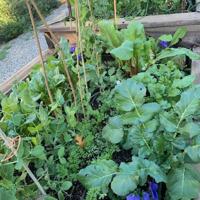As the Nevada County fair is in full swing, the temperatures are sure to ramp up as we get farther into August and into September. So why think about “cool season” or winter gardens now? As the days grow shorter and evening temperatures begin to fall, this is a good time to consider re-planting or starting a winter garden with cool season vegetables. Growing and maturing best when the temperatures are between 55° and 75°, cool season vegetables include some winter-hardy varieties that are easy to grow and full of nutritional value including vitamins C, A and K.
One advantage to growing cool season vegetables is that plants and soil lose less water to evaporation, thus requiring less supplemental water. And planting in the cool season has the additional benefit of winter rain. A well-hydrated plant will handle the cold better than one that is drought stressed, so be prepared to water if there is an extended dry spell in the winter. Winter crops generally have fewer pests and weeds, and they keep planting beds in use.
In planning a winter garden, select a site that maximizes sun exposure and benefits from the warmest microclimates in the area. Planting along a south facing wall or next to the house or a structure that may reflect heat are ideal locations. Concentrate on a site that is protected from cold, dry wind. The key is to get started early enough for plants to become established and mature. (Mature plants can withstand cold temperatures better than younger plants.) Many of the plants considered cool season vegetables such as lettuces, leeks, onions, mâché and kale can survive temperatures into the teens or even single digits, once established, especially if given some protection. Many tolerate light frost when mature, and some even sweeten with frost – especially kale, Brussel sprouts and cabbage.
The next big step is figuring out what to grow – as Master Gardeners say, “grow what you like to eat”. There are lists of cool season vegetables in many gardening books and on the UCANR and Master Gardener websites. Some of the vegetables suggested for direct seeding include carrots, beets, lettuce, peas, spinach, and Swiss chard. These cool season seeds can be sown anywhere from 15 to 60 days before the first frost. Remember, the first frost date will vary by elevation and local microclimates.
Starting a winter garden also involves an estimate as to the first fall frost date. A general rule of thumb is to start plants indoors about 6-weeks before the first frost date. A map in the UC Master Gardener’s Western Sierra Foothills Garden Guide provides the elevation contour and estimates for the average date of the first 32° F minimum temperature in the fall. For example, in Grass Valley we may see the first fall frost around November 20. This is just an estimate — as from past experience, frost may come any time in the fall. Therefore, if you count back 6 to 8 weeks (and depending on the variety of vegetable planted) the best time to direct sow seeds for winter crops could be between the end of August until the end of October. Brassicas may be started indoors well before the first fall frost, and can be transplanted as small “starts” in raised beds or inground in September. If frost is predicted, use a garden blanket or fabric cover to help protect plants from damage. Cauliflower and broccoli take a little longer to get started and may be transplanted from seed-starts, 45 to 105 days before the first frost. Kale will generally grow best 45 to 105 days before the first frost. Check seed packets or plant labels for specific directions as to when to plant in the late summer or early fall.
For more information about planting a winter garden, join the UC Master Gardeners of Nevada County for the free workshop on August 16 — “Cool Season Vegetable Gardening” to be presented from 10am to noon at the Demonstration Garden (1036 W. Main St. in Grass Valley). Learn how to keep your garden more fertile and productive almost year-round. Consider what you want to grow and what plants are considered cool-season vegetables; find out when and where to start your cool season crops and how to build healthy soil with cover crops.
Join us on August 23 for “Gardening with Deer”, and on September 6 our “Native Plants” workshop will be presented. Both of these workshops will be offered at the Demonstration Garden in Grass Valley. The UC Master Gardeners of Nevada County are also offering a few more mini-workshops on Saturday and Sunday at the Nevada County Fair (view the schedule at our website: https://ucanr.edu/site/uc-master-gardeners-nevada-county). Stop by our “barn” in the Family Farm area during the fair – we’ll have UC Master Gardeners on hand to answer your home gardening questions, and we have Little Sprouts children’s activities from 10:30 am – 12 pm and again from 1 pm – 2:30 pm.
Ann Wright is a Nevada County Master Gardener.


Comments are closed.